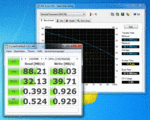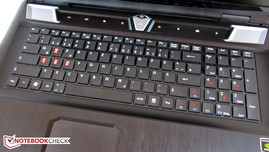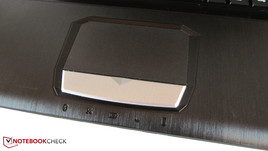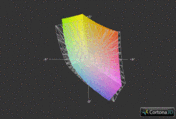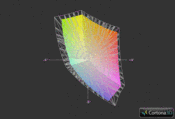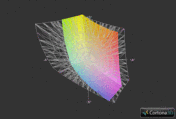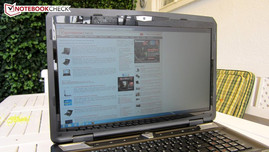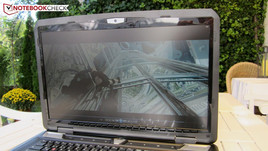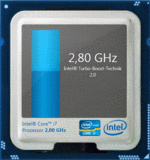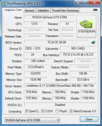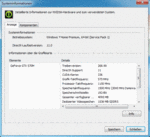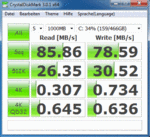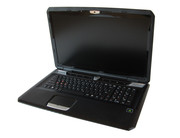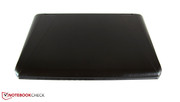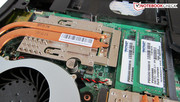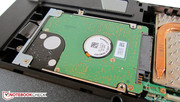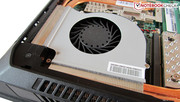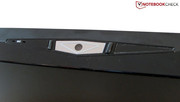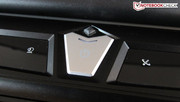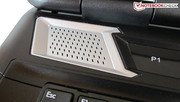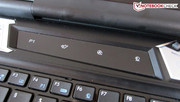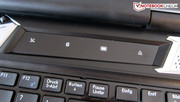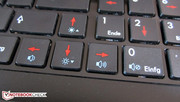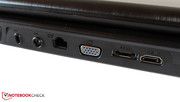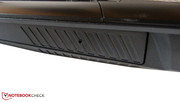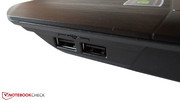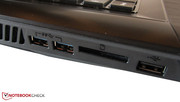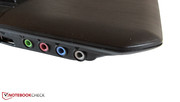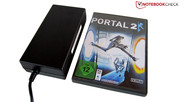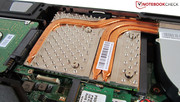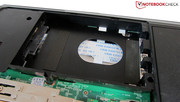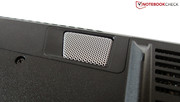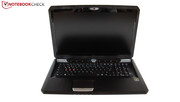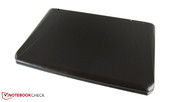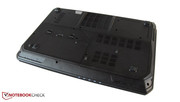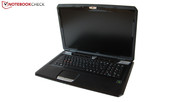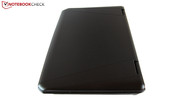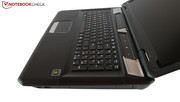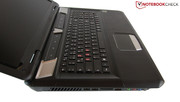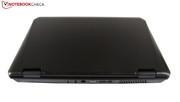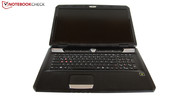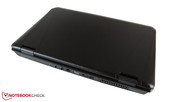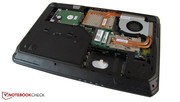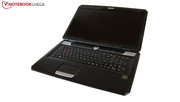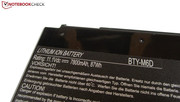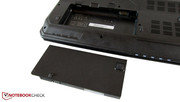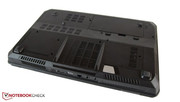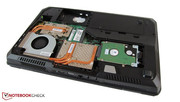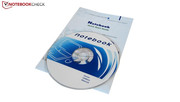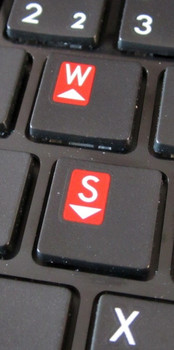Review Deviltech Fragbook Notebook
The Germany-based company, Deviltech, has specialized in selling configurable notebooks. Enthusiastic gamers that take a look at Deviltech's homepage will sooner or later end up at the attractively priced Fragbook.
Despite the powerful graphics card, Deviltech price tags the 17 inch device at under 1000€ (basic configuration). Nvidia's GeForce GTX 570M is a brand new, and until now hardly attainable DirectX 11 accelerator from the upper range. However, in contrast to the graphics card, it is absolutely advisable to upgrade the processor and RAM. A dual core CPU and two GBs of DDR3 RAM are no longer contemporary in the high-end range. We would recommend a combination of a Core i7-2630QM or i7-2760QM and four or eight GB of RAM.
Many potential buyers will likely be indecisive when it comes to choosing the hard disk. The array ranges from HDDs over SSDs up to hybrid models. There is also the option of installing two hard disks. Several variations are also possible for the optical drive. A modern BluRay drive can be built in instead of a conventional DVD burner upon selection (player or burner).
Standardly, there is no operating system included. Deviltech offers the 32 and 64 version of Windows 7 Home Premium, Professional and Ultimate. The customer can even choose the keyboard model. Basically, the price design is fair. There is hardly a manufacturer who can serve with a similarly good offer.
Case
The 17 inch case gives a lot of reason for debate. The opinions will likely strongly vary, in particular in terms of design and shape. While some will see the laptop as stylish and modern, others will consider the device to be frisky and modern. Should the device look familiar, it has been based on the more or less equally built MSI GT780R.
Deviltech uses an unobtrusive black in terms of colors. However, silver-gray elements, such as the unusually shaped speaker grids, set the one or other highlight. The device isn't very prone to smudge thanks to the matt surfaces. Only the glossy display bezel and glossy keyboard surface prove to attract dust. The 17 inch device conveys a solid quality impression. Alike most competitors, the case is made of plastic. Nevertheless, the workmanship is satisfactory and, with exception of the keyboard, all components have a fairly smooth transition.
Moreover, the case has a good stability. Except for the vents (bottom) and the loudspeaker vicinity, the case only yields under stronger pressure. The lid also can be warped easier and the hinges aren't quite perfect either. For one thing, opening needs quite a bit of strength and for another, the hinges aren't completely silent. At least the base unit stays down when opening. The Fragbook isn't really suitable to be a portable companion. The case is relatively bulky and heavy (approx. 6 cm (2.4") height and 3.7 kg (8.2 lbs) weight).
Connectivity
Interfaces
Apart from the omitted ExpressCard slot and FireWire port, we quite liked the scope of interfaces. In particular the left side and the rear prove to be generously equipped. External monitors are fed with video material either analog or digitally (VGA & HDMI). It is also possible to use a surround system thanks to four audio ports.
Five USB ports (2x USB 3.0) are also generous. Only few will want to connect more peripherals. Additionally, there is a card reader, a Kensington lock and an eSATA port. We can't really complain about the interface distribution. Since the most important ports are located at the rear, the lateral areas remain free to the largest extent.
Communication
A wireless module is included without an extra charge. Our test device was equipped with an Intel Centrino Wireless N 130 (2.4 GHz). It supports WLAN b/g/n and Bluetooth 2.1. The optionally available Bigfoot Killer N is superior in terms of software and features, but doesn't include Bluetooth.
Software
Deviltech pleasantly restrains itself in terms of preinstalled software. The gaming laptop is free of bloatware. The manufacturer limits itself to the most important software. The so-called "Eco mode" is worth mentioning. It can be enabled via an FN key combo and sets the display brightness as well as energy savings options to various scenarios such as "office", "movie" or "game".
Scope of Delivery
The scope of delivery is rather modest. Besides a bulky 180 watt power adapter and a strong 9 cell battery, Deviltech only includes a quick start guide and a driver & tool DVD in the box.
Warranty
The standard warranty has a runtime of 24 months. The warranty period can be extended to three years for an additional 150€.
Input Devices
Keyboard
The input devices were only satisfactory to an extent. We'll start with the keyboard that has a dedicated numpad, free-standing keys (14x14 mm/ 0.5"x0.5") and a pleasant typing feel. Volume and brightness control are feasibly mapped to the arrow keys – a good idea.
In return, the manufacturer shouldn't have tried out a new layout. The "<>" key and the "#" key aren't found in their usual places. The single-rowed "enter" key also needs getting used to. The cheap sounding typing noise and the omitted light are additional minus points.
Touchpad
The touchpad is one of the biggest drawbacks of the Fragbook. The mouse cursor responds rather imprecise and springy. The supported gestures (zoom, scroll & rotate) often react with delay or not at all. In the meantime, the undefined mouse keys are annoying due to their high pressure resistance.
But then again, the touchpad isn't a complete failure after all. The good size (83x47 mm / 3.3"x1.9") and the ratio of good feedback and gliding capability (slightly roughened surface) would be mentioned on the pro side. The deactivation option also earns praise.
Display
Matching to the strong innards, a Full HD model with an LED backlight is used for the screen (16:9). 1920x1080 pixels not only supply a sharp picture, but also allow the convenient use of multiple windows.
| |||||||||||||||||||||||||
Brightness Distribution: 89 %
Contrast: 988:1 (Black: 0.32 cd/m²)
61% AdobeRGB 1998 (Argyll 3D)
83.4% sRGB (Argyll 3D)
60.7% Display P3 (Argyll 3D)
Since the pricing is fairly low in view of the high performance components, we predicted that the display quality would be poor. But far from it: The installed CMO1720 screen can well compete with a good external screen.
Due to its low black value (0.32 cd/m2), dark areas don't fade to gray – unlike many competing products. The brightness is also great. Only few devices surpass 300 cd/m2. Overall, this results in an excellent contrast of 988:1. The colors make a strong impression despite the matt surface. Games and movies really come alive.
Another bonus point is the good viewing angles. The image first changes in large deviations. It makes a nice movie night with friends possible without problems. The only thing that we have to criticize about the screen is the grainy image reproduction. Homogeneous surfaces look coarse when looking closer.
Performance
Processor: Intel Core i7-2630QM
Unsurprisingly, Deviltech relies on Intel's latest Sandy Bridge generation for the processor. The buyer has to choose between a dual and a quad core model from the popular Core i5, respectively Core i7 range. Our test sample was equipped with the currently cheapest quad core model, Core i7-2630QM.
A default clock of 2.0 GHz may seem very low at first glance. However, it can automatically be overclocked up to 2.9 GHz thanks to the so-called Turbo Boost technology (provided the cooling is adequate). 995 million transistors and a six MB L3 cache aren't bad either.
Additionally, a few applications benefit from the Hyper Threading technology. It supports every physical core with a virtual counterpart. Thus, four additional cores are available and the Core i7-2630QM can process up to a total of eight threads at the same time. Beyond that, Intel embeds a graphics chip, called HD Graphics 3000, into the Sandy Bridge processors (not enabled in the Fragbook). The CPUs are manufactured in a 32 nm process. Note: The Core i7-2630QM will presumably be replaced by the i7-2670QM in the near future.
CPU Performance
As our Sandy Bridge comparison shows, most games are limited by the graphics card and not the processor. However, we would recommend using a quad core model because of its higher future security. We checked if it is worth upgrading from a Core i7-2630QM to the more expensive i7-2760QM (here the Schenker XMG P701 PRO) with Cinebench R10, among other benchmarks.
The Core i7-2760QM clearly has the lead in single core rendering (loads one core only). 5471 to 4598 points equals a plus of 19%. Both cores close in on one another in multi core rendering. The difference is now 15% with 19747 to 17219 points. The latest Cinebench R11.5 shows a similar performance ratio. While the Core i7-2760QM achieves a CPU score of 5.63 points, the Core i7-2630QM has to be satisfied with 4.9 points (-13%).
Graphics Card: Nvidia GeForce GTX 570M
Deviltech has hit a major homerun with the GeForce GTX 570M. Nvidia's brand new DirectX 11 graphics card is to close the vast gap between the top models, GTX 560M and GTX 580M. The specs, however, sometimes favor the one GPU and sometimes the other.
Based on the GF114 chip (Fermi architecture), the GeForce GTX 570M has a total of 336 of the possible 384 shader units activated (GTX 560M: 192). The clock rates are located at 575 MHz (core), 1150 MHz (shader) and 1500 MHz (memory). In comparison: While the GTX 580M runs on 620/1240/1500 MHz, the GTX 560 runs on 775/1550/1250 MHz. Alike the GTX 560M, the memory interface has a width of 192 bits (GTX 580M: 256 bits). Depending on the configuration, the GDDR5 VRAM has a size of 1536 or 3072 MB. The memory bandwidth is 72.0 GB/s.
Nvidia earns respect for the vast amount of supported features. The graphics card not only transmit a high definition picture, but also a full-fledged surround signal via HDMI – thanks to the incorporated HD audio controller. HD videos are accelerated with assistance from the video decoder named "VP4" and thus, the CPU is massively unloaded.
Additionally, it's possible to enable extended physical effects (PhysX) in certain games. The modified material can even be enjoyed in the third dimension (3D Vision) with the corresponding accessories (shutter glasses & a 120Hz monitor). The somewhat older ForceWare 268.0 GPU driver was preinstalled in our test sample.
GPU Performance
We wanted to focus on the DirectX 11 results in the graphic benchmarks. The Fragbook looked good in the demanding Unigine Heaven 2.1 benchmark (1280x1024, high, default tessellation). With 32.5 fps, the GeForce GTX 570M places itself in front of its smaller brother, GTX 560M (27.6 fps @ MSI GT780R), by 17%. In contrast to that, the GTX 570M can't hold a candle to the current reference. The GTX 580M calculates almost 40% faster (44.3 fps @ Schenker XMG P501).
The differences increase a bit in 3DMark 11 (1280x720, "Performance" setting, GPU score). With 2141 points, the GTX 570M is 18% better than the GTX 560M (1820 points), but 31% behind the GTX 580M (3110 points).
| 3DMark 03 Standard | 42034 points | |
| 3DMark 05 Standard | 22746 points | |
| 3DMark 06 Standard Score | 16679 points | |
| 3DMark Vantage P Result | 10678 points | |
| 3DMark 11 Performance | 2351 points | |
Help | ||
HDD Performance
As mentioned in the beginning, the Fragbook can accommodate a maximum of two hard disks (HDDs, SSDs or hybrid models). Deviltech installed a 500 GB HDD from Samsung, model HM500JJ, into our test sample. The performance is on a fairly good level not least due to its fast speed (7200 rpm). We could determine a transfer rate of 86.6 MB/s and an access rate of 15.5 ms with the tool, HDTune.
Naturally, the HDD can't keep up with a cutting edge solid state drive. SSD disks usually transfer data with over 200 MB/s at an access time of less than 0.4 ms. Load times are relatively short and the boot process are also faster with an SSD. The biggest disadvantage is still their current high price. One gigabyte costs a lot less in HDDs. Fortunately, it's possible to easily exchange the hard disk at any time.
System Performance
Because a solid state drive isn't used, the system performance lags behind its possibilities. A PCMark Vantage score of 8838 is very unspectacular. Many devices achieve the same score. Thus, Asus' VX7-SZ062V (Core i7-2630QM, GeForce GTX 460M) managed 8675 points, for example. Our reference score is from Schenker's XMG P701 PRO (Core i7-2760QM, Radeon HD 6990M). 20113 points are out of reach for most laptops. The Fragbook still managed 2446 points in PCMark 11.
| PCMark Vantage Result | 8838 points | |
| PCMark 7 Score | 2446 points | |
Help | ||
The GeForce GTX 570M had to face up to home made competition, namely the GTX 560M (MSI GT780R) and GTX 580M (Schenker XMG P501)
Crysis 2
The first person shooter is perfect for putting a laptop to a tough stress test. The GTX 570M has a very hard time with high-res textures, DirectX 11 patch and "Ultra" settings. 18 fps are equal to a very unsmooth picture structure. The frame rate increased significantly without DirectX 11 and high-res textures. We assessed 25.9 fps when 1920x1080 pixels and the setting "Extreme" were used.
The popular GeForce GTX 560M has just as a hard time. 19.4 fps are very remote from smooth game play. These settings first run reasonably acceptable with a Radeon HD 6990M or GeForce GTX 580M. The latter reached 34.1 fps in the test. The Fragbook shouldn't be set any higher than "Very High".
| Crysis 2 | |||
| Resolution | Settings | Value | |
| 1920x1080 | Ultra DX11 High Res Textures | 18 fps | |
| 1920x1080 | Extreme | 25.9 fps | |
| 1366x768 | Very High | 75.1 fps | |
| 1024x768 | High | 96.9 fps | |
| 800x600 | High | 103.1 fps | |
Dirt 3
Codemaster's flagship race game also brings the GeForce GTX 570M to its limits. The frame rate settled to 27.5 fps in the built-in benchmark with 1920x1080 pixels, 4x antialiasing (MSAA) and "Ultra" details – that's poor. While the GeForce GTX 560M lags behind by 15% (23.3 fps), the GeForce GTX 580M processes faster by a whole 61% (44.2 fps). But it's not at all necessary to give up nice graphics – Dirt 3 can be enjoyed smoothly with antialiasing, when the setting "High" is selected.
| Dirt 3 | |||
| Resolution | Settings | Value | |
| 1920x1080 | Ultra Preset, 4xAA, -AF | 27.5 fps | |
| 1360x768 | High Preset, 2xAA, -AF | 98.1 fps | |
| 1024x768 | Medium Preset, 0xAA, -AF | 129.7 fps | |
| 800x600 | Ultra Low Preset, 0xAA, -AF | 199.3 fps | |
Call of Duty: Black Ops
The successful first-person shooter from the developer, Tryarch, can't upset the Fragbook. The frame rate is agreeably high even when 1920x1080 pixels, four times antialiasing, eight times anisotropic filtering and the setting "Extra" are used. With 68.6 fps, the GeForce GTX 570M is in front of the GTX 560M by 7% (64 fps) and 21% behind the GTX 580M (87.3 fps). Incidentally, a graphics card level with the GT 555M would suffice for the maximum looks.
| Call of Duty: Black Ops | |||
| Resolution | Settings | Value | |
| 1920x1080 | extra, 4xAA, 8xAF | 68.6 fps | |
| 1360x768 | high, 2xAA, 4xAF | 94.2 fps | |
| 1024x768 | medium, 0xAA, 0xAF | 100.4 fps | |
| 800x600 | low (all off), 0xAA, 0xAF | 126.1 fps | |
Starcraft 2
Users are perfectly equipped for the intensive multi-player battles of StarCraft 2 with the GeForce GTX 570M. 1920x1080 pixels and the setting "Ultra" presented us with an average of 42.2 fps – a good result. The GeForce GTX 580M again took a clear lead. 58.8 fps equals a plus of 39%. In return, the more attractively priced GTX 560M had to be satisfied with (a still playable) 35.2 fps.
| StarCraft 2 | |||
| Resolution | Settings | Value | |
| 1920x1080 | ultra | 42.2 fps | |
| 1360x768 | high | 79 fps | |
| 1360x768 | medium | 97.1 fps | |
| 1024x768 | low | 257.2 fps | |
Battlefield: Bad Company 2
The first person shooter "Bad Company 2", released in 2010, isn't a big problem for the Fragbook. The GeForce GTX 570M can present high details, 4x antialiasing and 8x anisotropic filtering fairly smooth. The tool, Fraps, calculated 40.1 fps in the native resolution. In view of 34.3 fps, the GeForce GTX 560M clearly has a harder time with these settings (14%). The top rank is occupied by the GeForce GTX 580M (50.9 fps).
| Battlefield: Bad Company 2 | |||
| Resolution | Settings | Value | |
| 1920x1080 | high, HBAO on, 4xAA, 8xAF | 40.1 fps | |
| 1366x768 | high, HBAO on, 1xAA, 4xAF | 78.1 fps | |
| 1366x768 | medium, HBAO off, 1xAA, 1xAF | 105.8 fps | |
| 1024x768 | low, HBAO off, 1xAA, 1xAF | 135.8 fps | |
Gaming Performance Verdict
The GeForce GTX 570M's gaming performance is overall impressive. Although it's not always enough for the maximum details in the native Full HD resolution, high details can usually be applied. The majority of the tested games ran smoothly even with enabled antialiasing.
However, the GeForce GTX 570M doesn't have any chance against Nvidia's reference model. In the end, it is a plus of 35% for the GTX 580M. Meanwhile, the GTX 560M frequently installed in high-end laptops falls behind by 15%. Deviltech wouldn't have been able to wring out more gaming power for the targeted price. The Fragbook is a good deal for frugal gamers.
| low | med. | high | ultra | |
|---|---|---|---|---|
| Need for Speed Shift (2009) | 110.7 | 95.1 | 58.7 | |
| Resident Evil 5 (2009) | 145.1 | 110.8 | 69.2 | |
| Risen (2009) | 131.4 | 86.5 | 60.6 | 40.5 |
| CoD Modern Warfare 2 (2009) | 199.1 | 107 | 89.9 | 59.8 |
| Battlefield: Bad Company 2 (2010) | 135.8 | 105.8 | 78.1 | 40.1 |
| Metro 2033 (2010) | 101.5 | 65 | 32.4 | 12.5 |
| StarCraft 2 (2010) | 257.2 | 97.1 | 79 | 42.2 |
| Mafia 2 (2010) | 101.5 | 88.6 | 78.5 | 49.6 |
| Fifa 11 (2010) | 474.6 | 337.1 | 245.9 | 164.6 |
| Call of Duty: Black Ops (2010) | 126.1 | 100.4 | 94.2 | 68.6 |
| Crysis 2 (2011) | 103.1 | 96.9 | 75.1 | 25.9 |
| Dirt 3 (2011) | 199.3 | 129.7 | 98.1 | 27.5 |
| Deus Ex Human Revolution (2011) | 178.7 | 83.9 | 32.4 | |
| F1 2011 (2011) | 135 | 96 | 79 | 40 |
| Fifa 12 (2011) | 393 | 297.2 | 235.3 | 159.1 |
Emissions
System Noise
Besides the unreliable touchpad and the fairly bulky and heavy case, the high noise development is the Fragbook's third major flaw. The notebook isn't exactly quiet already in idle mode. The fan occasionally rotates at a very perceptible level.
As usual for gaming laptops, it generates such a loud noise that it easily drowns quiet game scenes in load. The Fragbook even almost cracked the 50 dB (A) mark in full load operation. Moreover, our test sample emitted an annoying humming noise during load. According to Deviltech, this problem has been eliminated in the meantime and should no longer turn up in the final production models.
By the way, we wouldn't recommend using the fan control (above the keyboard) because the fan also runs perfectly without increasing its speed. Nevertheless, this feature could be interesting for overclockers.
Noise level
| Idle |
| 33 / 36.6 / 39.3 dB(A) |
| DVD |
| 40.7 / dB(A) |
| Load |
| 42.3 / 49.2 dB(A) |
 | ||
30 dB silent 40 dB(A) audible 50 dB(A) loud |
||
min: | ||
Temperature
There is hardly reason for complaint in terms of temperatures. The case's cool wrist rest especially impressed us. The laptop's front area remained below 30°C (86F) even during full load. The fan's vicinity gets a lot warmer during load, but a maximum of 39°C (102.2F) are absolutely acceptable. Most gaming notebooks achieve much higher case temperatures: More than 50°C (122F) is not uncommon.
The stress test (Furmark & Prime) didn't come up with any nasty surprises. The graphics card and processor remained below 90°C (194F), according to the tool Hardware Monitor. No throttling was recorded. The Fragbook ran absolutely stable over the entire testing period. Thus, the cooling system seems to be adequate for the high-end components.
(+) The maximum temperature on the upper side is 38.3 °C / 101 F, compared to the average of 40.5 °C / 105 F, ranging from 21.2 to 68.8 °C for the class Gaming.
(+) The bottom heats up to a maximum of 39.2 °C / 103 F, compared to the average of 43.3 °C / 110 F
(+) In idle usage, the average temperature for the upper side is 25.8 °C / 78 F, compared to the device average of 33.9 °C / 93 F.
(+) The palmrests and touchpad are cooler than skin temperature with a maximum of 27.1 °C / 80.8 F and are therefore cool to the touch.
(±) The average temperature of the palmrest area of similar devices was 28.9 °C / 84 F (+1.8 °C / 3.2 F).
Speakers
The sound quality of the built-in 2.1 system is quite good for laptop conditions. The deep pitches are also adequately rendered due to the built-in subwoofer. Both speakers score with a high maximum volume. Nevertheless, more would have been possible. Compared to a full-fledged sound system, the sound appears to be a bit muffled, imprecise and synthetic. If possible, the user should connect external speakers. Fairly good stereo models are available for under 50€. Users who want good built-in speakers might take a liking to the Asus G74 or Toshiba Qosmio X770.
Battery Life
Naturally, high-end components aren't exactly easy on energy. 21.4-34.7 watts (idle), respectively 115.7-192.6 watts (load) are typical for a premium gaming notebook. A comparison: The Eurocom Racer (Core i7-2720QM), equipped with a Radeon HD 6970M, consumes a bit more in idle mode and a bit less during load.
| Off / Standby | |
| Idle | |
| Load |
|
Key:
min: | |
Despite the 9 cell battery (87 Wh, 7800 mAh), the runtimes are rather commonplace. When the 17 inch laptop is put under heavy load and the maximum display brightness is set, the user will be faced with a black screen after about an hour.
The laptop lasts considerably longer during less demanding tasks. Our test DVD ran for two hours and fifteen minutes. A wireless Internet connection was kept upright for two hours and forty-five minutes. The battery life increases even more in minimum brightness and maximum energy saving options. We could wring almost five hours out of the Fragbook in optimal conditions. Some gaming notebooks are drained after not even two hours in idle mode.
Verdict
Deviltech has set up a very interesting gaming platform with the Fragbook. The 17 inch case doesn't necessarily belong to the most compact and lightest of its kind, but it can score with good connectivity and resistant, matt black surfaces.
The high quality display is the biggest unique selling point. Brightness, black value and contrast are beyond any doubt. Since it is an anti-glare screen, the Fragbook can even be used outdoors. Another reason for buying would be the outstanding performance. Nvidia's GeForce GTX 570M renders new games smoothly even in high details; Intel's Core i7-2630QM provides a high future security thanks to four cores. Gamers don't have to worry about the temperatures here: The case surfaces and components don't get exceedingly warm.
In return, the input devices leave us with mixed feelings. The keyboard's unconventional layout annoyed us, the touchpad proved to be extremely finicky. The 17 inch laptop looses more rating points through the high noise level (is true for almost every gaming laptop). The fan is anything but quiet during load; noise sensitive users should preferably look around for an alternative.
Overall, we can pat Deviltech on the back though. We would have actually reckoned with a lot more drawbacks in view of such a strong and fair-priced gaming notebook.






